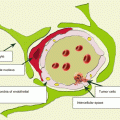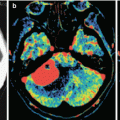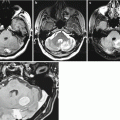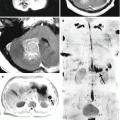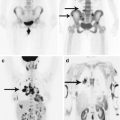, Valery Kornienko2 and Igor Pronin2
(1)
N.N. Blockhin Russian Cancer Research Center, Moscow, Russia
(2)
N.N. Burdenko National Scientific and Practical Center for Neurosurgery, Moscow, Russia
According to many researchers, an increase of infectious and parasitic diseases of the central nervous system has been noted worldwide, despite the emergence of new therapies and the establishment of antimicrobial and anti-inflammatory pharmaceuticals (Yakhno and Shtulman 2001; Whiteman et al. 2002). This increase is partly attributed to the spread of acquired immunodeficiency syndrome (AIDS), as well as the use of immune-suppressing drugs to treat cancer and to perform organ transplants. Emergence of life-threatening infectious diseases of the central nervous system may be associated with a number of adverse factors, such as staying in the focus of infection, presence of an open head injury, cerebrospinal fluid leakage, sinusitis, otitis media, etc., especially in a compromised immune system. In these cases of decisive importance is early diagnosis of the disease. Such imaging methods as CT and MRI are particularly important for a comprehensive neurologic and laboratory (CSF analysis) investigation.
39.1 Bacterial Infection
A variety of pathogenic agents (bacterial, viral, fungal, and parasitic) may penetrate into the brain tissue through the blood or via a direct contact with the source of infection. Characteristics of the brain structure—absence of lymphocytes, a small number of capillaries in the subarachnoid space, and the presence of perivascular cerebrospinal fluid spaces—may result in an inflammatory reaction caused by pathogens entering the intracranial or intravertebral spaces. CSF, in particular, is an excellent medium for dissemination of an infectious process. Pathogens can penetrate the brain tissue and induce focal (abscesses, cysts) or diffuse (encephalitis) lesions and inflammation of the meninges (meningitis, ependymitis, arachnoiditis) or cerebrospinal fluid spaces (subdural and epidural empyema).
Inflammation of the brain and its membranes is usually accompanied by intense abnormal accumulation of the contrast agent in CT and MRI images. In cases of encysted and multiple lesions, the X-ray picture is similar to that in metastases.
Brain abscesses are a relatively rare intracranial pathology accounting for, according to different sources, 1–8% depending on the level of economic development of the country, where the study was carried out (Bhatia et al. 1973; Osenbach and Loftus 1992). The growing number of patients with HIV infection resulted in an increased incidence of brain abscesses. The male to female ratio is 2:1, while the average age of onset is 35–45 years. In 25% of cases, brain abscesses develop in children and adolescents younger than 15 years of age. Until 2 years of age, brain abscess is rarely diagnosed, mainly after meningitis caused by Citrobacter diversus or other gram-negative bacteria.
In adults, brain abscesses developing due to hematogenous metastasizing most often are caused by anaerobic bacteria or a mixture of aerobic and anaerobic bacteria. In children, the most common pathogens are staphylococci, streptococci, and pneumococci. In patients with head trauma or those undergoing surgery, abscesses are typically caused by Staphylococcus aureus.
Predisposing factors for the development of brain abscesses are chronic lung infections, osteomyelitis, cholecystitis, gastrointestinal infection, and purulent skin diseases (furunculosis, etc.). Therefore, inflammatory emboli carried over from the extracranial structures may be called “infectious metastases.”
Standard CT and MRI methods used in the differential diagnosis of cerebral space-occupying lesions have high sensitivity (95%) but low specificity (50–60%); it is not always possible to give a definite answer about the origin of an abnormal intracranial lesion. The use of additional CT-MRI perfusion and MR-diffusion methods, as well as MR spectroscopy increases the specificity and provides the possibility to avoid diagnostic errors in the diagnosis (Chang et al. 2002; Fertikh et al. 2007; Kastrup et al. 2008; Chiang et al. 2009; Shetty et al. 2010; Pal et al. 2010; Hsu et al. 2013; Ozbayrak et al. 2015).
On T2-weighted MRI, early cerebrosides are visualized as areas of increased signal intensity, weakly or virtually indistinguishable from the surrounding edema. Proton density-weighted MR images and T2-weighted and T2-FLAIR MR images allow to detect cerebritis earlier than CT, visualizing initial changes in the brain. On T1-weighted MRI, cerebritis appears isointense or hypointense relative to the intact brain tissue, with a possible mass effect, which manifests in the compression of gyri and/or the adjacent ventricle. On T1-weighted MRI, lesions with subacute microhemorrhages in the affected area as hyperintense areas relative to the normal or edematous brain substance. Contrast enhancement is usually slightly pronounced and inhomogeneous in the earliest stage. On CT, the affected area can be either undetected or visualized as the area with decreased density without clear boundaries with the brain.
A cerebritis focus eventually transforms into an abscess in its central portion of the liquid necrosis areas, which is well visualized on CT and particularly on MRI and is limited by a collagenous capsule (Fig. 39.1).
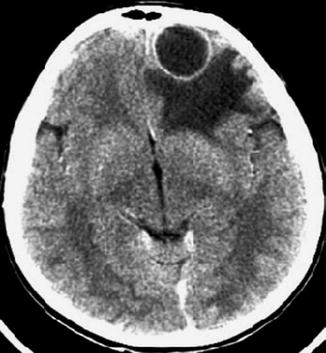

Fig. 39.1
An abscess. On CT with contrast enhancement, in the left frontal area, there is a rounded space-occupying lesion with a thin capsule and a pronounced perifocal edema
The most characteristic CT and MRI feature of a formed abscess is a rounded lesion with a thin-walled capsule, intensely accumulating the contrast agent (a “ring” phenomenon), with clear and smooth inner contours (Fig. 39.2).


Fig. 39.2
An abscess. On T2-weighted (a), T1-weighted (b), and T1-weighted MRI after intravenous contrast enhancement (c), in the deep parts of the right frontoparietal region, there is a rounded space-occupying lesion with a thin capsule intensely accumulating the contrast agent and a pronounced perifocal edema
In typical cases, the central part of the abscess has a reduced density on CT and a heterogeneously modified MR signal on MRI, increased on T2-weighted MRI and decreased on T1-weighted MRI relative to the brain. Thus, on T1-weighted MRI, the signal from the abscess center is always higher than that from the cerebrospinal fluid in the lateral ventricles. On T2-weighted MRI, the signal intensity varies depending on the choice of the echo time (TE) in the spin echo pulse sequence, protein composition, and viscosity of the central cavity contents.
On non-contrast enhanced MRI, a mature abscess often has a distinctive rim around its edge. The signal on the edge of an abscess is isointense or slightly hyperintense than the signal of the white matter on T1-weighted MRI and hyperintense on T2-weighted MRI. Properties of the MR signal on the abscess edge are associated with collagen, products of hemorrhages, and the presence of paramagnetic free radicals in macrophages involved in the phagocytosis and heterogeneously distributed along the abscess periphery (Lai et al. 2005). With successful surgical or therapeutic treatment of the abscess and a decrease in the activity of phagocytes, the hyperintensive rim on T1-weighted MRI degrades. Thus, the presence of the rim may serve as a better indicator of the treatment course than the residual contrast enhancement that can be observed on MRI with contrast enhancement for several months after the treatment.
Multiple abscesses are rare (Fig. 39.3). A supratentorial location is typical for brain abscesses. In practice, however, abscesses in the posterior fossa also can be encountered.
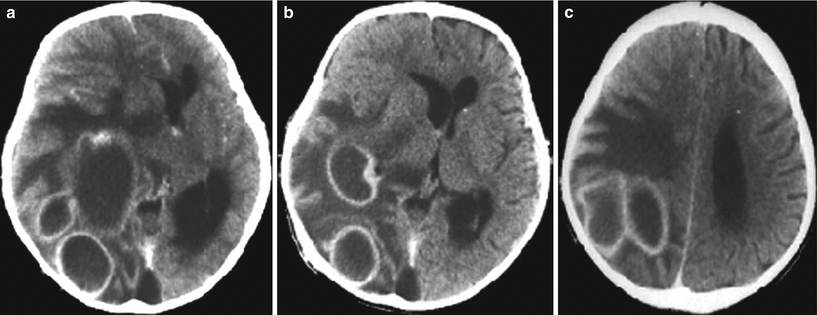

Fig. 39.3
Multiple abscesses. A three-level study. On CT scans in the axial projection with contrast enhancement (a–c) on the background of a pronounced cerebral edema, there is ring-shaped accumulation of the contrast material in the walls of multiple abscesses in the temporo-parietal-occipital region. The right lateral ventricle is drastically compressed, and the ventricular system is severely displaced to the left
DWI MRI usually reveals a marked increase in the MR signal from the central parts of the abscess (purulent-necrotic area), indicating a decrease in the diffusion of water molecules in the specified area. ADC values in the central zone and capsule of the abscess are significantly lower (p < 0.005) than in the white matter of the brain (Table. 39.1) with diffusion factor of b = 500 and b = 1000 s/mm2.
Table 39.1
The apparent diffusion coefficient (ADC) of water molecules in abnormal brain tissues
ADC × 10−3 (mm2/s) | Abscess (b = 500 s/mm2) | Abscess (b = 1000 s/mm2) | Glioblastoma (b = 1000 s/mm2) |
|---|---|---|---|
Abscess capsule/tumor | 1.01 ± 0.16 | 0.997 ± 0.09 | 1.18 ± 0.09 |
Edema | 1.83 ± 0.31 | 1.65 ± 0.25 | 1.59 ± 0.16 |
Pus/necrosis | 0.58 ± 0.14 | 0.65 ± 0.15 | 2.15 ± 0.34 |
White matter | 0.84 ± 0.07 | 0.80 ± 0.04 | 0.82 ± 0.04 |
Table 39.1 compares the ADC values inside the annular contrast-enhancement area of abscesses and glioblastomas. In patients with glioblastomas, the necrotic area in the center of the tumor had higher ADC values than in abscesses.
The reason for limited movement of the water molecules in the central portion of the abscess is primarily attributed to the presence of pus, having a high viscosity and containing large amounts of cellular components and debris. Ebisu et al. (1996), studying in vitro the pus aspirated from the abscess, found an increase in MR signal on DWI and low ADC values on ADC maps.
At the same time, it should be noted that not every abscess content has low values on ADC maps. According to our study, in approximately 25% of cases, ADC parameters from pus may be greater than those from the white matter. The explanation for this may be the effect of high T2 value from purulent masses on ADC values when constructing the maps (Fig. 39.4).
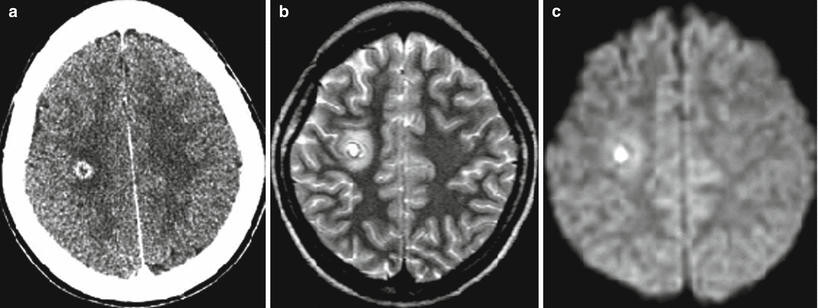

Fig. 39.4
Brain abscess. On CT (a) in the right frontal lobe of the brain, there is a microannular lesion. On T2-weighted MRI (b), a small-sized rounded lesion with a perifocal edema is detected. An MR signal is typically high on DWI sequences (c)
Proton MR spectroscopy is another method of increasing the MRI specificity in the differential diagnosis of brain abscesses (Dev et al. 1998; Burtscher and Holtas 2001). MR spectra obtained from the central part of the abscess have quite specific characteristics. In the spectra of untreated abscesses, there are peaks of acetate (1.92 ppm), lactate (1.3 ppm), alanine (1.5 ppm), succinate (2.4 ppm), and a pyruvate complex (0.9 ppm), which includes amino acids valine, leucine, and isoleucine. Acetate, lactate, pyruvate, and succinate are metabolic end products associated with microbial activity. Acetate and succinate are never found in necrotic tumors and, therefore, are specific markers of pyogenic abscesses (Fig. 39.5).
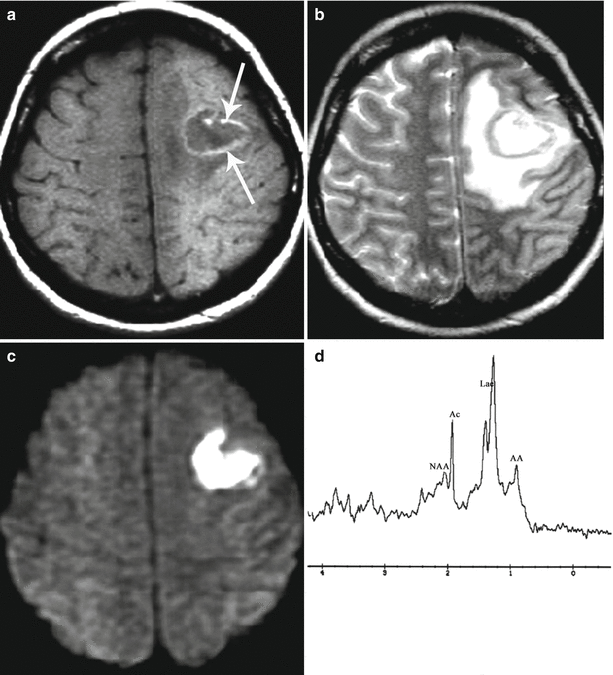

Fig. 39.5




Brain abscess. On T1-weighted (a) and T2-weighted MRI (b), in the left frontal region, there is a rounded space-occupying lesion with a fairly thick capsule and a perifocal edema. The abscess capsule has an increased signal on T1-weighted MRI (arrows) and a hypointense signal on T2-weighted MRI. On diffusion MRI (c), there is typically a high MR signal; the presence of acetate (Ac), lactate (Lac), and amino acid peaks (AA) is detected by MR spectroscopy (d). The NAA peak is reduced
Stay updated, free articles. Join our Telegram channel

Full access? Get Clinical Tree




